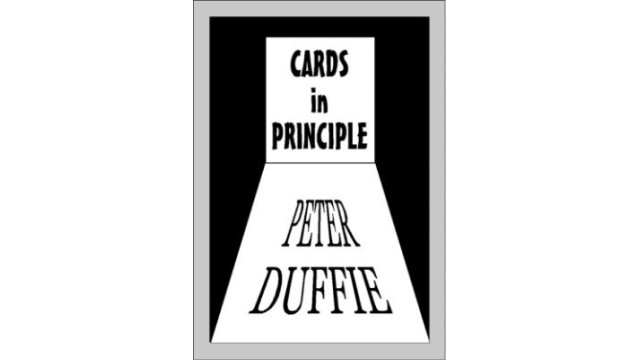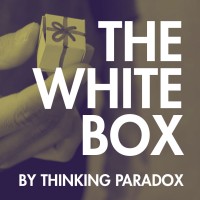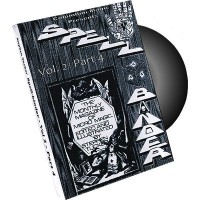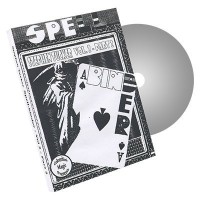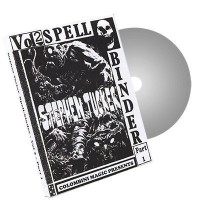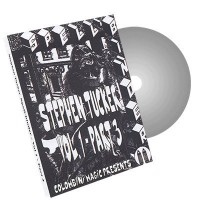Cards In Principle by Peter Duffie
- Product Code: I1296B
- Reward Points: 10
- Availability: In Stock
- $6.99
-
$2.99
- Price in reward points: 299
1st edition, 1994.
AUTO - SPLIT: A mysterious double card revelation, where a spectator manages to separate the colours of the cards with the exception of two selections. Interestingly, you never touch the cards!
THE SUABIAN TWIST: There have been several combinations of Dai Vernon's 'Twisting the Aces' and 'The Hofzinser Ace Problem' over the years. If the following version has any merit, it is the simple means by which the one at a time reversal is accomplished.
AURA BEST: This is a fairly puzzling routine based on Paul Curry's 'The Whispering Joker'. In this version there are no cards out of the deck before you start.
EVERY PICTURE TELLS A STORY: This effect was inspired by Simon Dixon's 'Paradox Aces' which appeared in Abacus, V61.2 N6.11, which in turn was based on Martin Gardner's 'Paradox Papers' (Pallbearers Review, page 429).
THE PallaD PRINCIPLE: A strange series of transpositions occur as a spectator deals a packet of cards. Once set in motion, the principle employed is both automatic, and perpetual. The idea of using a third packet as a leader was suggested to me by Roy Walton.
WALTON'S "WARM-UP": Here is a further idea from Roy Walton which turns the previous principle into a commercial routine, and adds an excellent climax.
THE DEMONIQUE DEAL: A staggered (not staggering) version of the classic Daley(?) Mental Poker effect. Four people should be seated at the table.
THE DIARY OF EXPECTATION: Inspired by Ted Danson's 'It's a Date,' the following simple rendition of the classic diary prediction uses one diary and one regular deck. The principle used is the well known 14/15 stack.
SOLID GOLDE - EASY ACTION: The following is a variation of Roger Golde's "The Favorites" which appeared in V61.17, No.2 of Apocalypse. The principle used was devised by Bob Hummer.
SUBCONSCIOUS POKER FOR TWO: The following is a variation of Joseph K. Schmidt's "Subconscious Poker Il" which first appeared in Pallbearer's Review, and subsequently in his excellent book, Modern Close-up Card Problems.
QUANTITY SURVEYOR: The following came about while playing with a reverse stack principle belonging to Howard Adams. However, only the actions of the Adams idea remain as the principle now used is much older. I'll leave the presentation to the individual.
PET SYMMETRY: Here is a handling of the Hamilton/Finnell Free Cut Principle in which the relevant sections are never placed back together again once the selections have been made and the cut off portions dropped on the opposite piles.
IDEAL HOLMES: The effect of the following was inspired by Steve Hamilton's 'Thinking Out Loud' (see The Crimp, No.10, and Roger's Thesaurus, by Roger Crosthwaite and Justin Higham). However, the principle employed stems from an observation made by Tom Sellers' in "A Trick with the Si Stebbins Pack" in Card Tricks That Work.
ALL SQUARE FORECAST: Stewart James seems to be among the first to realize the true potential of the magic square when applied to individual cards rather than simply having figures on a grid. While the following adaptation of the idea requires duplicates, it does render a very strong double prediction for the formal occasion.
DITTO: This magi-comedy mental item is based on Phil Goldstein's 'Preoction' from his 1985 Madrid lecture notes. It also bears some resemblance to 'Potty Prediction' and other like effects. A little initial preparation is required but if you are a performer then I think you will consider that part trivial.
NUMB .... ers: A George Sands/Shigeo Futagawa principle is combined with that of the magic square matrix to arrive at a insoluble number prediction. Interested readers may wish to compare this with "A Sense of Freedom" that appeared in my manuscript Ulterior Motifs.
THOTOVER: This effect originally appeared in Abacus V61.2 No.6. It is basically a transposition of a very simple construction. Since its publication I found a related idea by Tom Sellers in his booklet Card Tricks that Work. This one works too.
EIGHTSUM: The following item is based on Lewis Jones' 'Happenstance' which appeared in issue Number 5 (May 1994) of Apocalypse.
WALTZ WITH THE DEVIL: This is a more logical presentation for 'Dance with the Devil' which I published in the final issue 18 of Profile. The principle used is Karl Fulves' "Self-Correcting Set-Up" (Epilogue, issue 3, July 1968.) In my original presentation, the number fourteen was used instead of the preferred thirteen. This has now been rectified.
SURE THING: The following prediction was partly inspired by Alex Elmsley's "Mexican Prediction" which appeared in The Collected Works, Vol.II. However, the method here uses the standard one ahead to achieve its goal.
A BRAINSTORM IN GLASGOW: This started off rather basic with the two Jokers trapping a quantity of cards equal to the value of the face card of a freely cut packet, using the natural properties of the Down/Under Deal. I would like to thank George McBride for adding the suit divination, and Roy Walton for making the removal of the selection from the packet possible. Now it's a good trick!
word count: 10550 which is equivalent to 42 standard pages of text
Reviews (0)
Related Products
Sublimations by Roger Curzon
Roger Curzon - Sublimations PDF + show piece. A superb collection of Mental, New Age and Bizarre Mag..
$2.99 $5.48
Glass by Adam Grace
Adam Grace - Glass is a new genre in magic! Fifteen effects with a small pane of glass a..
$1.99 $4.99
The Best Of Pentagram Card Magic by Martin Breese
Fabulous collection of card magic culled from the pages of The Pentagram, including an e..
$6.99 $12.98
The Collected Works Of Alex Elmsley Vol. 2 by Stephen Minch
In The Collected Works of Alex Elmsley, the magic of this extraordinary inventor is brought together..
$3.99 $6.99
Potpourri 3 by Nick Conticello
A Further Collection of Impromptu, Sleightless, Mathematical Tricks Nick Conticello is proud to pre..
$2.99 $5.99
The Ultimate Guide To The Pass by Alex Pandrea
INCLUDING 7 PASSES TAUGHT BY ALEX PANDREA Classic Pass Brick Pass 2.0 Cover Pass..
$3.99 $6.98
Shared Secrets by Devin Knight
This PDF is called Shared Secrets because several well-known performers in the past, ..
$1.99 $4.99
Rehab by Gabbo
Everyday people turn over money for cigarettes. Imagine if you could rehab and turn those cigarettes..
$1.99 $4.99
Bite by Jose Prager
The Bite is a very useful and subtle principle that allows you to mark billets or cards in a un..
$2.99 $5.99
Cerebral Approach Book 5 - Twin Killing by Nick Conticello
Problem: To divine or locate two cards that are merely thought of by two persons. This effect has i..
$1.99 $4.99
Woody On Stebbins (1-4) by Woody Aragon
This is a must-have series for anyone interested in strong, entertaining and impossible card magic, ..
$4.99 $9.99
Episode #2 by Stewart James In Action
Stewart James is one of the most prolific creators in all of magic history. He created over 2,000 ma..
$2.99 $5.99
Episode #3 by Stewart James In Action
Stewart James is one of the most prolific creators in all of magic history. He created over 2,000 ma..
$2.99 $5.99
Stewart James in Action by Madison Hagler (Episode 1-3)
Stewart James is one of the most prolific creators in all of magic history. He created over 2,000 ma..
$2.99 $5.99
Scrapbook Issue 8 by Alexander De Cova
MY MAGIC SQUARE - I worked a long time to get together my "perfect" magic square. This one is differ..
$1.99 $4.99
Ulterior Motifs by Peter Duffie
Twenty card tricks from the inventive Scotsman.1st edition, 1992.THOSE ENIGMATIC ROYALS: A simple id..
$6.99 $17.00
The Magic Square - Tricking Your Way to Mental Superpowers by Lewis Smile
It's quick, it's easy, and it will confuse people for reasons that will be frustrating and alien.Thi..
$0.99 $16.99
Art Trivia by David Jonathan, Nikolas Mavresis, & TCC Magic
David Jonathan and Nikolas Mavresis team up with TCC to present a unique, funny, and memorable packe..
$2.99 $14.00
Arcardia by Roger Crosthwaite
"I have just watched Roger's Real Gone Aces and thoroughly enjoyed what I saw. You caught me several..
$3.99 $14.00
Gerald Kein – Correcting Non-Organic Male Impotence
In this seminar, Jerry Cain explains how to use hypnotherapy to treat psychosomatic impotence.Discov..
$4.99 $25.00
Gerald Kein – Hypnotic Phobia Removal
Seminar on how to remove phobias with the help of hypnosis. Gerald Kane, as always, speaks intellige..
$4.99 $25.99
Recommend
The Series Vol 1 Color Change by Cheng Lin
The Series Vol 1 Color Change by Cheng Lin As one of the most skilled underground magicians in New ..
$1.99 $4.48
At The Table Live Lecture The Other Brother
At the Table Live Lecture starring The Other Brothers You may not have heard of the Other Brothers...
$1.99 $4.99
At The Table Live Lecture Chris Brown
At the Table Live Lecture by Chris Brown Chris "Orbit" Brown, creator of countless moves, effects, ..
$1.99 $4.28
El Punto by Asi Wind
El Punto by Asi Wind Cl??sico efecto en las manos y en la versi??n del Neoyorkino Asi Wind. Una bel..
$1.99 $4.99
Pintare Al Centro by Yves Carbonier
Yves Carbonier - Pintare al centroBonita tecnica hecha efecto, que podras usar en muchas rutinas.06:..
$1.99 $4.99
Tinta Viajera by Xulio Merino
Xulio Merino - Tinta viajeraOtra inclreible ruitna de bolas de esponja de este gran mago...
$1.99 $4.99
Hebe Production by Willy Monroe
Willy Monroe - Hebe ProductionProduccion de billetes, de la loca mente de Willy Monroe, que podras u..
$1.99 $4.99
14 Mi Numero De La Suerte by Toni Montana
Toni Montana - 14 Mi numero de la suertedemo:https://www.youtube.com/watch?v=EXgz7vyMRZkEfecto de me..
$1.99 $4.48
The White Box by Thinking Paradox
Thinking Paradox - The White BoxFrom the Thinking Paradox team, creators of bestsellers BOND and CLE..
$1.99 $4.28
Spellbinder Dvd 2 - Part 4 by Stephen Tucker And Wild-Colombini Magic
Stephen Tucker and Wild-Colombini Magic - Spellbinder DVD 2 - Part 4Product DescriptionRoutines Perf..
$1.99 $4.68
Spellbinder Dvd 2 - Part 3 by Stephen Tucker And Wild-Colombini Magic
Stephen Tucker and Wild-Colombini Magic - Spellbinder DVD 2 - Part 3Product DescriptionROUTINES PERF..
$1.99 $4.68
Spellbinder Dvd 2 - Part 2 by Stephen Tucker And Wild-Colombini Magic
Stephen Tucker and Wild-Colombini Magic - Spellbinder DVD 2 - Part 2Product DescriptionSpell-binder ..
$1.99 $4.68
Spellbinder Dvd 2 - Part 1 by Stephen Tucker And Wild-Colombini Magic
Stephen Tucker and Wild-Colombini Magic - Spellbinder DVD 2 - Part 1Product DescriptionROUTINES PERF..
$1.99 $4.68
Spellbinder Dvd 1 - Part 3 by Stephen Tucker And Wild-Colombini Magic
Stephen Tucker and Wild-Colombini Magic - Spellbinder DVD 1 - Part 3Product DescriptionROUTINES PERF..
$1.99 $4.68
Spellbinder Dvd 1 - Part 2 by Stephen Tucker And Wild-Colombini Magic
Stephen Tucker and Wild-Colombini Magic - Spellbinder DVD 1 - Part 2Product DescriptionROUTINES PERF..
$1.99 $4.68

